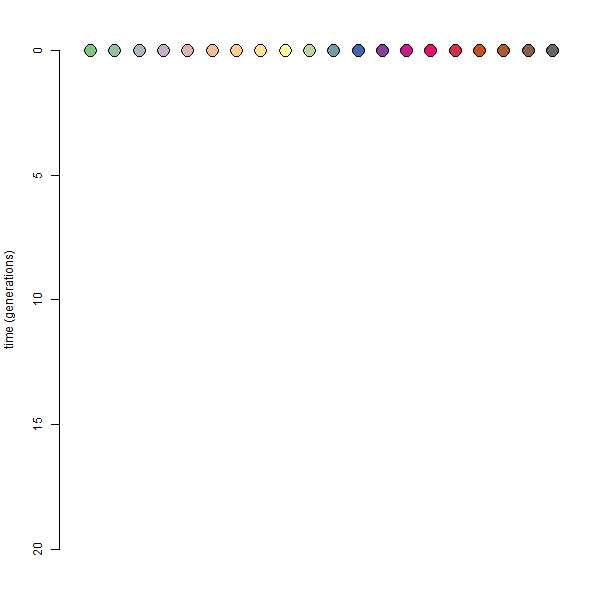Nowadays every evolutionary genetics seems to feature the same plot illustrating genealogical coalescence. You know the one - it usually consists of different colored circles or squares connected by lines meant to represent parent-daughter relationships? I thought it would be handy to reproduce this in R. Here's my function which will shortly join my PopGen package on GitHub:
coalescent.plot<-function(n=10,ngen=20,colors=NULL,...){
if(hasArg(sleep)) sleep<-list(...)$sleep
else sleep<-0.2
if(is.null(colors)) colors<-rainbow(n=n)
popn<-matrix(NA,ngen+1,n)
parent<-matrix(NA,ngen,n)
popn[1,]<-1:n
for(i in 1:ngen){
parent[i,]<-sort(sample(1:n,replace=TRUE))
popn[i+1,]<-popn[i,parent[i,]]
}
plot.new()
par(mar=c(2.1,4.1,2.1,1.1))
plot.window(xlim=c(0.5,n+0.5),ylim=c(ngen,0))
axis(2)
title(ylab="time (generations)")
cx.pt<-2*25/max(n,ngen)
points(1:n,rep(0,n),bg=colors,pch=21,cex=cx.pt)
for(i in 1:ngen){
dev.hold()
for(j in 1:n){
lines(c(parent[i,j],j),c(i-1,i),lwd=2,
col=colors[popn[i+1,j]])
}
points(1:n,rep(i-1,n),bg=colors[popn[i,]],pch=21,
cex=cx.pt)
points(1:n,rep(i,n),bg=colors[popn[i+1,]],pch=21,
cex=cx.pt)
dev.flush()
Sys.sleep(sleep)
}
}
OK, let's try it!
library(RColorBrewer)
n<-20
cols<-colorRampPalette(brewer.pal("Accent",n=8))(n)
par(bg="grey",fg="white")
coalescent.plot(n=n,colors=cols,ngen=15)
The color scheme is arbitrary & the grey background / white foreground is just for effect - but I like it!
Note that the plot shown is static, but in R it is animated. Here's what I mean:
coalescent.plot(n=n,colors=cols,ngen=20)

(Note that I also made the above animation using ImageMagick, but
I also had to modify the code of coalescent.plot to include
a call to dev.print for every generation of the simulation.)
That's it.
I was working on something similar but more complex: My idea is to simulate the history of multiple populations that can exchange alleles and where the alleles can spontaneously mutate. I wonder if you can suggest a way to model these sceanria in a time-efficient way with R. Thanks in advance!
ReplyDeletePS: My way was like this: Use a list of length n (# of populations) with 2 vectors in each entry, i) the current alleles (initially numberes from 1:metapopulation.popsize) in the population, ii) immigrating alleles + current alleles. Sample from ii) and create a new i). Then, pick alleles with chance = mutation.rate and change the value to a new value that doesn't already exist.
DeleteThat way I hoped to simulate the spread given alleles in generation 0 under given mutation and migration rates and estimate these parameters after many simulation runs with approximate Bayesian computation (ABC). However, my approch is too slow to perfrom a few million runs (it takes about 7 s for 1 single run)